Discover the Charm of Green in Bali Rice Fields
The rice terraces draw tourists through their spectacular visual beauty, but that is not the only reason to pay them a visit. The Subak system itself is a window through which you can learn about the culture and religion of Bali.
Few sights can take your breath away quite like the vibrant green terraces of Bali’s famous rice fields. Let’s discover where to see the most beautiful and photogenic Bali rice fields on your tour of Indonesia. Before the list, we will talk more about the rice terraces and the role they play in sustainable agriculture as well as the province’s spiritual heritage.
Introducing Bali’s Famous Rice Terraces
Balinese farmers have been creating rice terraces since the 9th century as part of a system for irrigation known as Subak.

The rice terraces draw tourists through their spectacular visual beauty, but that is not the only reason to pay them a visit. The Subak system itself is a window through which you can learn about the culture and religion of Bali.
What Should You Know About Subak?
The ancient irrigation system called Subak comprises 1,200 or so water collectives that all draw their supply from a single source. You will find rice paddies connected to the Subak system in the Pakerisan River watershed, Catur Angga Batukaru, and along the shores of Lake Batur. It is at Lake Batur that you will also find the Supreme Water Temple of Pura Ulun Danu Batur.
From a technical standpoint, the irrigation system involves the use of tunnels, canals, and low-head dams called weirs to transport the water to the terraced rice fields. Various temples and villages are involved in the upkeep of this system.
Environmentally-conscious travelers will be just as enraptured by the Subak system itself as they are with the rice fields. The beauty of Subak extends beyond the aesthetic loveliness of the fields to encompass the spiritual philosophy of sustainability that is at the system’s heart.
That philosophy is known as Tri Hita Karana, which means “three reasons of prosperity” or “three causes of well-being.” The three causes are living in harmony with God, living in harmony with nature, and living in harmony with other people.

Since Subak is sustainable, it was developed in harmony with nature. Rituals at the water temples bring people together to work on Subak and also align participants with a higher spiritual purpose. This makes it the perfect demonstration of Tri Hita Karana in action. Thus, Subak is not only a marvel of agricultural engineering, but a source of deeper inspiration. It shows what a society can create when its people join together in harmony—a system that can work for centuries.
Where to find the Best Rice Fields in Bali?
1. Tegallalang Rice Fields
Close to Tegalalang and Ubud, you will find one of Bali’s most iconic rice fields. Tegallalang is a UNESCO World Heritage Site, and a fantastic example of Subak at work.
How to Reach It
These rice terraces are less remote than many in Bali. If you are hiking, you can get to Tegallalang Rice Fields from Ubud in about two hours. To save time, rent a motorbike or car; you will get there in about 20 minutes. Taxi services also run to this Bali rice terrace.

What Makes It Unique
The irrigation system at Tegallalang sculpts the landscape into picturesque terraces that are rich, vibrant green. They are gorgeous from a height, but equally beautiful if you descend into the valley from a different angle. You will appreciate how well-maintained they are; this is due in part to their popularity with visitors.
As you enter the rice fields, you will notice a swing set with a sign that says “I [HEART] BALI” on it. Along with snapping photos, you can take a turn on the swings yourself.
If you are walking briskly and not pausing a lot, you can see Tegallalang in about half an hour. But the hike presents many lovely viewpoints, and you are going to want to get your camera out often. Plan for at least an hour and a half to experience Tegallalang to its fullest.
What Else Can You Do Nearby?
While you are visiting Tegallalang, another destination to add to your bucket list is the nearby Bali Pulina coffee plantation. Here you can find out all about what goes into brewing Balinese coffee, and enjoy a cup or two yourself.
2. Jatiluwih Rice Fields
Next, you will want to explore the Jatiluwih Rice Fields, which are just north of Penebel in the Tabanan Regency.
How to reach it
If you are starting out in Ubud, Sanur or Canggu, you can reach Jatiluwih Rice Fields by car or motorbike. Try the southern entrance by Pura Luhur Besi Kalung. It costs less than the northern entrance.

What Makes It Unique
Whereas Tegallalang is in a valley, Jatiluwih rice fields are wide open, giving the location a completely different look and feel. There is a walkway you can use to traverse the bright green fields. From many spots, you will be able to see distant mountains. While walking along the path is easy, you can cycle if you prefer.
One thing you will love about Jatiluwih is the flavor of authenticity. Unlike Tegallalang, you are unlikely to find yourself wading through other tourists, even during peak season. You will instead have a little slice of quiet, serene paradise, and will be able to watch the rice workers going about their daily lives in peace.
If you want to fly a drone to explore and take photos, there is a $10 USD fee. For a Western tourist, we think this is very affordable.
What Else Can You Do Nearby?
While visiting this area, you will be able to stop by Yeh Hoo Waterfall along with a couple of other modest but beautiful falls.
3. Tenganan Rice Fields
These rice fields await you next to Tenganan Pegeringsingan Village, which is located in the eastern part of Bali.

How to Reach It
You will be able to reach this area by driving for about two hours if you are starting in Ubud or Kuta.
Be aware that you can either hike to the fields from Tenganan Village, or you can do so from Kastala, which is also close by. The hike from Kastala is actually easier since there is a steep elevation change from Tenganan.
What Makes It Unique
The fields in Tenganan are another example of rice paddies that are off the beaten track and usually not filled with tourists. Due to their proximity to the villages, however, there are tours you can book that will show you around the paddies and the surrounding area.
A word of warning—it is best to stay on the path and glance down often. While snakes are prevalent throughout Bali’s rice paddies, they seem particularly abundant here.
What Else Can You Do Nearby?
The main attraction besides the rice fields is the village of Tenganan itself. It is a peaceful place where you can pay one of the local residents to take you on a tour to learn about traditional Balinese life. You will love the window of insight you get into the culture, labor, crafts and history of rural Bali. Plus, the chance to get to know the friendly locals is a fantastic bonus.
4. Munduk
Munduk Rice Terraces are located in the northern part of Bali and are a must-see destination for your scenic bucket list.

How to Reach It
If you are starting out from Ubud, you can arrive at Munduk after about two hours of driving. You might want to park by the main road rather than using the access road; it has a steep grade that makes driving a challenge. Just be aware that doing this adds another hour of hiking before you get to the rice fields.
What Makes It Unique
The rice paddies of Munduk are surrounded by jungle, creating a lush setting. They are also situated at a higher elevation than many of the other paddies in Bali. That means the temperature is generally cooler, which makes hiking around the area easier and more enjoyable.
What Else Can You Do Nearby?
The Munduk Waterfall is a popular destination close to the rice paddies. While you are on your way there, you will also be able to hike past other waterfalls such as Munduk Red Coral Waterfall, Labuhan Kebo Waterfall, Golden Valley Waterfall and Melanting Waterfall.
Pura Ulun Danu Temple is located close to the Munduk rice fields as well. This is a very exciting destination to visit, and should be part of any rice paddy tour. Remember, it is the Supreme Water Temple. All the water you see used for irrigating the rice terraces in this region comes from Lake Bratan, where the temple is situated. Spend a couple of hours here taking pictures and learning about the temple and Subak.
When is the Best Time to Visit the Balinese Rice Fields?
We suggest visiting the rice fields in Bali during the wet season, which starts in October and continues through March. This is when the rice fields turn the deepest shade of green. That said, they are still stunning during the dry season, and you may prefer the weather then. So, no matter what time of year you drop by, you cannot go wrong.
Additional Tips for Your Visit to Balinese Rice Fields
To ensure that you have the best experience when you explore each Bali rice field, here are a few ways you should prepare for your adventure.

- Get ready for the sun. Although there are some rice fields in cooler parts of Bali, many of them are concentrated in hot, humid areas. Dehydration is a real concern, as you are going to be doing a lot of walking and spending hours in the sun, quite often with no shade. Bring a full canteen of water, and consider wearing a hat or carrying a sun umbrella. Applying sunscreen is also wise.
- Bring some extra cash. Balinese rice terraces are privately owned. You cannot just stroll in for free without permission; you will need to pay an entrance fee to the owners. It is wise to bring along more money than you think you will need, as you might want to purchase refreshments or pay for extra services (like flying a drone or taking photos with the locals). Don’t worry—visiting Bali rice fields is super affordable.
- Say hello to the locals. The workers at Balinese rice fields are generally very friendly. They will have as much fun meeting you as you will meeting them. So, do not be shy.

- Know the rules. While it is fun to talk to the locals in the rice fields, take care that you are not disruptive. Do not take too much of their time, as they need to keep up with their work. Also, if you want to fly a drone, check first if it is allowed, and if so, if there is a fee.
- Wear close-toed shoes. Protecting your feet is important since there are so many snakes around the paddies. Chances are good they will not wander into the path, and if they do, you will spot them. But you can never be too safe. Some of them do bite and are venomous.
Behold the Harmony of Subak Bali Rice Fields
Every Bali paddy field we have shared with you in the list above is worth a visit; each has its own distinctive charm and will inspire you not just with picturesque views, but with an infusion of spirituality, sustainability, and timeless culture that has endured through the ages.




